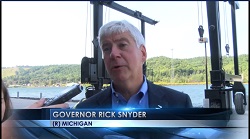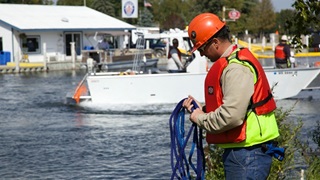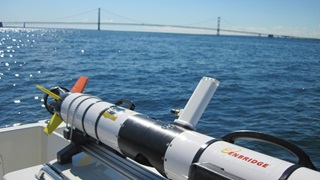Keeping the Straits safe for everyone
Michigan Tech's new monitoring buoy to report water current data in real time
For all kinds of marine traffic, it’s essential to go with the flow.
And thanks to some state-of-the-art instrumentation at Michigan Technological University, we’ll soon know exactly what that flow looks like in the Straits of Mackinac.

TV NEWS COVERAGE: Watch Michigan Gov. Rick Snyder and state Rep. Scott Dianda praise Michigan Tech's environmental monitoring buoy as an important safety measure in the Straits.
Over the next couple of weeks, Michigan Tech’s Great Lakes Research Center (GLRC) expects to deploy a real-time environmental monitoring buoy in the Straits of Mackinac, where Lake Michigan and Lake Huron meet. The GLRC will stream data collected by the buoy directly to a publicly accessible website, where the information will benefit everyone who uses one of the most heavily travelled waterways in North America.
“Right now, there is no real-time reporting of water currents in the Straits, even though the traffic is so heavy in the area,” says Dr. Guy Meadows, director of the GLRC. “For large-scale shipping traffic, it’s important to have flow information, as you’re entering constricted areas, to enhance safety. For organizations like the Coast Guard and the Michigan State Police, knowing currents in advance is extremely important.
“We’re hoping this monitoring buoy will not only be useful for our own needs – but for those of the federal government, for carriers, for the fishing and tourist industries,” adds Dr. Meadows. “From our point of view, it’s a win all the way around.”
Equipped with an Acoustic Doppler Current Profiler, the new buoy will report information on the constantly changing waves and currents in the Straits of Mackinac with updates every 10 minutes on Michigan Tech's Upper Great Lakes Observing System website. Like 16 others in this Great Lakes monitoring network, the buoy will also measure conditions like wind direction and speed, water temperature, and wave height and direction.
And in tandem with the GLRC’s new supercomputer, nicknamed Superior, the buoy will allow GLRC technicians to predict currents in the Straits to a much finer detail.
Enbridge’s Line 5, which travels under the Straits of Mackinac, carries light crude oil and natural gas liquids (NGLs), powering Michigan’s economy and heating Michiganders’ homes.
With a rigorous original design, and vigilant operations and maintenance, the Line 5 Straits of Mackinac crossing has never experienced a leak in more than 60 years. We’re committed to keeping it that way with proactive and innovative measures that include:
- Diligent 24/7 monitoring of the crossing, using human and automated resources, with remote valve shutoff within three minutes;
- Regular inspections, using inline tools, expert divers, and remote operating vehicles (ROVs), that are carried out more frequently than regulations require;
- Supporting the line’s extraordinary design and construction standards, which were co-ordinated by the Bechtel Corporation, with the installation of additional screw anchor supports;
- Working with Dr. Meadows’ group at Michigan Tech to test and enhance an Autonomous Underwater Vehicle (AUV) that maps the bottom of the Straits near the Line 5 crossing.
Enbridge is further enhancing safety in the Straits of Mackinac by sponsoring the operation of this GLRC monitoring buoy for the next two years.
“The buoy provides an additional layer of monitoring in the area to keep our pipelines safe, and protect this safe and important waterway,” says Dave Hoffman, Enbridge’s senior manager of Research, Development, and Innovation.
“With the expertise of the GLRC, this important information will keep the Straits safe for everyone.”










